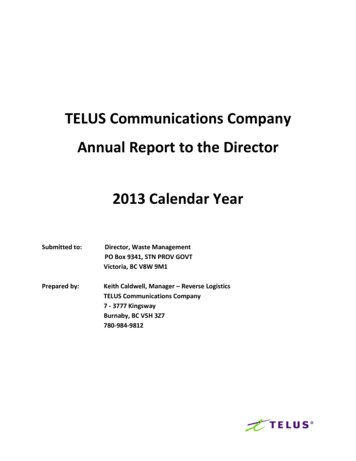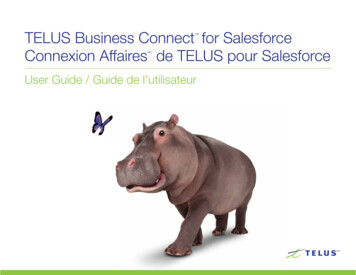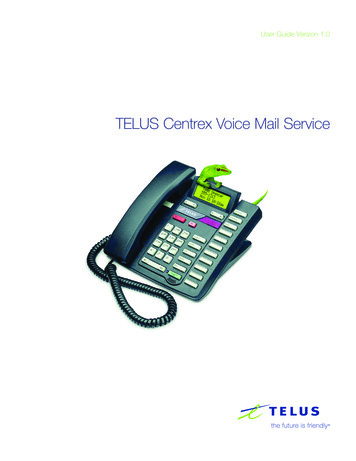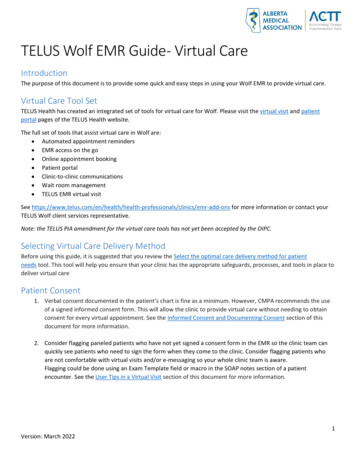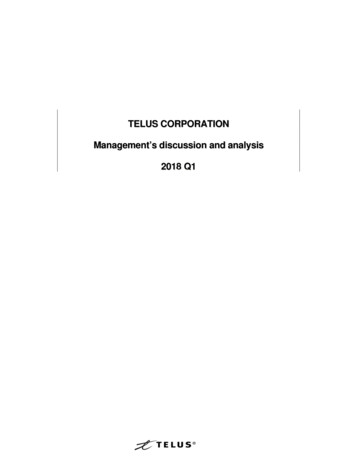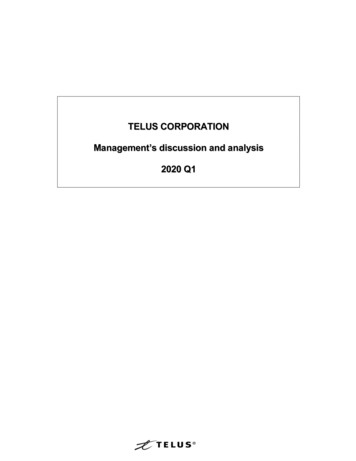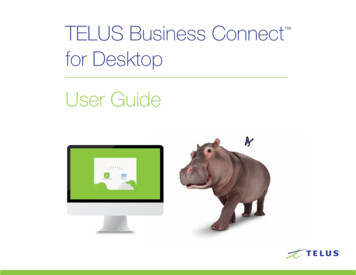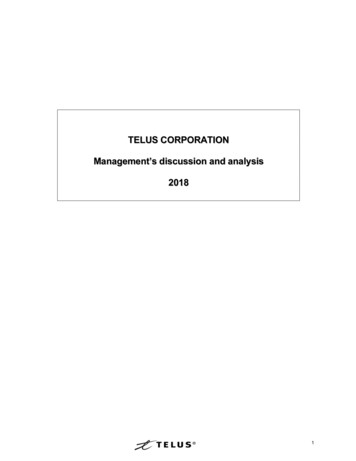
Transcription
TELUS CORPORATIONManagement’s discussion and analysis20181
TELUS Corporation – Management’s discussion and analysis – 2018Caution regarding forward-looking statementsThe terms TELUS, the Company, we, us and our refer to TELUS Corporation and, where the context of the narrative permits orrequires, its subsidiaries.This document contains forward-looking statements about expected events and our financial and operating performance.Forward-looking statements include any statements that do not refer to historical facts. They include, but are not limited to, statementsrelating to our objectives and our strategies to achieve those objectives, our targets, outlook, updates, and our multi-year dividendgrowth program. Forward-looking statements are typically identified by the words assumption, goal, guidance, objective, outlook,strategy, target and other similar expressions, or future or conditional verbs such as aim, anticipate, believe, could, expect, intend, may,plan, predict, seek, should, strive and will. These statements are made pursuant to the “safe harbour” provisions of applicable securitieslaws in Canada and the United States Private Securities Litigation Reform Act of 1995.By their nature, forward-looking statements are subject to inherent risks and uncertainties and are based on assumptions,including assumptions about future economic conditions and courses of action. These assumptions may ultimately prove to have beeninaccurate and, as a result, our actual results or events may differ materially from expectations expressed in or implied by the forwardlooking statements. Our general outlook and assumptions for 2019 are presented in Section 9 General trends, outlook andassumptions, and regulatory developments and proceedings in this Management’s discussion and analysis (MD&A).Risks and uncertainties that could cause actual performance or events to differ materially from the forward-looking statementsmade herein and in other TELUS filings include, but are not limited to, the following: Regulatory decisions and developments including changes to our regulatory regime or the outcomes of proceedings, cases orinquiries relating to its application, such as: the potential of government intervention to further increase wireless competition andany new regulatory requirements as a result of the CRTC’s planned review to be commenced in 2019 of the wholesale wirelessregulatory framework; the potential for government intervention concerning the CRTC’s decision on lower-cost data-only plans;changes to the cost burden associated with CRTC-mandated network interconnections; disputes with certain municipalitiesregarding rights-of-way bylaws, and other potential threats to unitary federal regulatory authority over telecommunications,including provincial wireless and consumer protection legislation; the impact of the CRTC’s wireline wholesale services review,with a review of rates and configurations for wholesale access currently in progress for TELUS; the CRTC’s forthcoming report onthe retail practices of Canada’s large telecommunications carriers, as directed by the Governor in Council; the CompetitionBureau’s market study on competition in broadband services; the CRTC’s phase-out of the local service subsidy regime andcorresponding establishment of a broadband funding regime to support the enhancement of high-speed Internet services focusingon underserved areas in Canada; the CRTC’s review of the price cap and local forbearance regimes; the CRTC’s proceeding tocreate a mandatory code of conduct to address the clarity and content of contracts for retail fixed Internet access and relatedissues; broadcasting-related issues, such as: the CRTC’s implementation of new initiatives discussed in its May 2018 report“Harnessing Change: The Future of Programming Distribution in Canada”; the federal government’s review of the BroadcastingAct, Telecommunications Act and Radiocommunication Act as announced on June 5, 2018; the review of the Copyright Act, whichbegan in early 2018; spectrum and compliance with licences, including our compliance with licence conditions, changes tospectrum licence fees, spectrum policy determinations such as restrictions on the purchase, sale and transfer of spectrumlicences, and the amount of spectrum TELUS is able to acquire and its cost under the Technical, Policy and Licensing Frameworkfor Spectrum in the 600 MHz Band auction, as well as cost and availability of spectrum in the 3500 MHz and mmWave bands; theimpact on us and other Canadian telecommunications carriers of government or regulatory actions with respect to certaincountries or suppliers; restrictions on non-Canadian ownership and control of TELUS Common Shares and the ongoingmonitoring and compliance with such restrictions; and our ability to comply with complex and changing regulation of the healthcareand medical devices industry in the provinces of Canada in which we operate, including as an operator of health clinics. Competitive environment including: our ability to continue to retain customers through an enhanced customer service experience,including through the deployment and operation of evolving wireless and wireline infrastructure; intense wireless competition,including the ability of industry competitors to successfully combine a mix of high-speed Internet access (HSIA) and, in somecases, wireless services under one bundled and/or discounted monthly rate, along with their existing broadcast or satellite-basedTV services; the success of new products, new services and supporting systems, such as home automation security, and Internetof Things (IoT) services for Internet-connected devices; wireline voice and data competition including continued intense rivalryacross all services among wireless and wireline telecommunications companies, cable-TV providers, other communicationscompanies and over-the-top (OTT) services, which, among other things, places pressures on current and future average billingper subscriber unit per month (ABPU), average revenue per subscriber unit per month (ARPU), cost of acquisition, cost ofretention and churn rate for all services, as do customer usage patterns, increased data bucket sizes or flat-rate pricing trends forvoice and data, inclusive rate plans for voice and data and availability of Wi-Fi networks for data; mergers and acquisitions ofindustry competitors; pressures on high-speed Internet and TV ARPU and churn rate resulting from market conditions,government actions and customer usage patterns; residential and business network access line (NAL) losses; subscriberadditions and retention volumes, and associated costs for wireless, TV and high-speed Internet services; our ability to obtain andoffer content on a timely basis across multiple devices on wireless and TV platforms at a reasonable cost; vertical integration in thebroadcasting industry resulting in competitors owning broadcast content services, and timely and effective enforcement of relatedregulatory safeguards; our ability to compete successfully in customer care and business services (CCBS) given our competitors’brand recognition, consolidation and strategic alliances as well as technology development and, in our TELUS Health business,our ability to compete with other providers of electronic medical records and pharmacy management products, systems integratorsand health service providers including those that own a vertically integrated mix of health services delivery, IT solutions, andrelated services, and global providers that could achieve expanded Canadian footprints.2
TELUS Corporation – Management’s discussion and analysis – 2018 Technological substitution including: reduced utilization and increased commoditization of traditional wireline voice local and longdistance services from impacts of OTT applications and wireless substitution, a declining overall market for paid TV services,including as a result of content piracy and signal theft and as a result of a rise in OTT direct to consumer video offerings and virtualmultichannel video programming distribution platforms; the increasing number of households that have only wireless and/orInternet-based telephone services; potential wireless ABPU and ARPU declines as a result of, among other factors, substitution tomessaging and OTT applications; substitution to increasingly available Wi-Fi services; and disruptive technologies, such as OTTIP services, including Network as a Service in the business market, that may displace or re-rate our existing data services. Technology including: high subscriber demand for data that challenges wireless networks and spectrum capacity levels and maybe accompanied by increases in delivery cost; our reliance on information technology and our need to streamline our legacysystems; the roll-out and evolution of wireless broadband technologies and systems including video distribution platforms andtelecommunications network technologies (broadband initiatives, such as fibre to the premises (FTTP), wireless small-celldeployment, 5G wireless and availability of resources and ability to build out adequate broadband capacity); our reliance onwireless network access agreements, which have facilitated our deployment of wireless technologies; choice of suppliers andthose suppliers’ ability to maintain and service their product lines, which could affect the success of upgrades to, and evolution of,technology that we offer; supplier limitations and concentration and market power for network equipment, TELUS TV andwireless handsets; the performance of wireless technology; our expected long-term need to acquire additional spectrum capacitythrough future spectrum auctions and from third parties to address increasing demand for data; deployment and operation of newwireline broadband network technologies at a reasonable cost and availability and success of new products and services to berolled out using such network technologies; network reliability and change management; self-learning tools and automation thatmay change the way we interact with customers; and uncertainties around our strategy to replace certain legacy wireline networktechnologies, systems and services to reduce operating costs. Capital expenditure levels and potential outlays for spectrum licences in spectrum auctions or from third parties, due to: ourbroadband initiatives, including connecting more homes and businesses directly to fibre; our ongoing deployment of newerwireless technologies, including wireless small cells to improve coverage and capacity and prepare for a more efficient and timelyevolution to 5G wireless services; utilizing acquired spectrum; investments in network resiliency and reliability; subscriber demandfor data; evolving systems and business processes; implementing efficiency initiatives; supporting large complex deals; and futurewireless spectrum auctions held by Innovation, Science and Economic Development Canada (ISED) including the 600 MHzspectrum auction scheduled to take place in March 2019 which will result in increased expenditures. Our capital expenditure levelscould be impacted if we do not achieve our targeted operational and financial results. Operational performance and business combination risks including: our reliance on legacy systems and ability to implement andsupport new products and services and business operations in a timely manner; our ability to implement effective changemanagement for system replacements and upgrades, process redesigns and business integrations (such as our ability tosuccessfully integrate acquisitions, complete divestitures or establish partnerships in a timely manner, and realize expectedstrategic benefits, including those following compliance with any regulatory orders); our ability to identify and manage new risksinherent to new service offerings that we may provide, including as a result of acquisitions, which could result in damage to ourbrand, our business in the relevant area or as a whole, additional exposure to litigation or regulatory proceedings; and real estatejoint venture risks. Data protection including risks that malfunctions or unlawful acts could result in the unauthorized access to, change, loss, ordistribution of data, which may compromise the privacy of individuals and could result in financial loss and harm to our reputationand brand. Security threats including intentional damage or unauthorized access to our physical assets or our IT systems and networks,which could prevent us from providing reliable service or result in unauthorized access to our information or that of our customers. Ability to successfully implement cost reduction initiatives and realize planned savings, net of restructuring and other costs, withoutlosing customer service focus or negatively affecting business operations. Examples of these initiatives are: our operatingefficiency and effectiveness program to drive improvements in financial results; business integrations; business productsimplification; business process outsourcing; offshoring and reorganizations, including any full-time equivalent (FTE) employeereduction programs; procurement initiatives; and real estate rationalization. Implementation of large enterprise deals, which may be adversely impacted by available resources, system limitations and degreeof co-operation from other service providers. Foreign operations and our ability to successfully manage operations in foreign jurisdictions, including managing risks such ascurrency fluctuations. Business continuity events including: our ability to maintain customer service and operate our network in the event of human erroror human-caused threats, such as cyberattacks and equipment failures that could cause various degrees of network outages;supply chain disruptions, delays and economics including as a result of government restrictions or trade actions; natural disasterthreats; epidemics; pandemics; political instability in certain international locations; information security and privacy breaches,including data loss or theft of data; and the completeness and effectiveness of business continuity and disaster recovery plans andresponses. Human resource matters including: recruitment, retention and appropriate training in a highly competitive industry, and the level ofemployee engagement. Financing and debt requirements including: our ability to carry out financing activities, our ability to refinance our maturing debt, ourability to maintain investment grade credit ratings in the range of BBB or the equivalent. Our business plans and growth could benegatively affected if existing financing is not sufficient to cover our funding requirements.3
TELUS Corporation – Management’s discussion and analysis – 2018 Lower than planned free cash flow could constrain our ability to invest in operations, reduce debt or return capital to shareholders,and could affect our ability to sustain our dividend growth program through 2019. This program may be affected by factors such asthe competitive environment, economic performance in Canada, our earnings and free cash flow, our levels of capitalexpenditures and spectrum licence purchases, acquisitions, the management of our capital structure, and regulatory decisionsand developments. Quarterly dividend decisions are subject to assessment and determination by our Board of Directors (Board)based on our financial position and outlook. Shares may be purchased under our normal course issuer bid (NCIB) when and if weconsider it opportunistic, based on our financial position and outlook, and the market price of TELUS shares. There can be noassurance that our dividend growth program or any NCIB will be maintained, not changed and/or completed through 2019. Taxation matters including: interpretation of complex domestic and foreign tax laws by the relevant tax authorities that may differfrom our interpretations; the timing and character of income and deductions, such as tax depreciation and operating expenses; taxcredits or other attributes; changes in tax laws, including tax rates; tax expenses being materially different than anticipated,including the taxability of income and deductibility of tax attributes; elimination of income tax deferrals through the use of differenttax year-ends for operating partnerships and corporate partners; and changes to the interpretation of tax laws, including as a resultof changes to applicable accounting standards or tax authorities adopting more aggressive auditing practices, tax reassessmentsor adverse court decisions impacting the tax payable by us. Litigation and legal matters including: our ability to successfully respond to investigations and regulatory proceedings; our ability todefend against existing and potential claims and lawsuits (including intellectual property infringement claims and class actionsbased on consumer claims, data, privacy or security breaches and secondary market liability), or to negotiate and execute uponindemnity rights or other protections in respect of such claims and lawsuits; and the complexity of legal compliance in domesticand foreign jurisdictions, including compliance with competition, anti-bribery and foreign corrupt practices laws. Health, safety and the environment including: lost employee work time resulting from illness or injury, public concerns related toradio frequency emissions, environmental issues affecting our business including climate change, waste and waste recycling, risksrelating to fuel systems on our properties, and changing government and public expectations regarding environmental matters andour responses. Economic growth and fluctuations including: the state of the economy in Canada, which may be influenced by economic and otherdevelopments outside of Canada, including potential outcomes of yet unknown policies and actions of foreign governments; futureinterest rates; inflation; unemployment levels; effects of fluctuating oil prices; effects of low business spending (such as reducinginvestments and cost structure); pension investment returns, funding and discount rates; and fluctuations in foreign exchangerates of the currencies in the regions in which we operate, and the impact of tariffs on trade between Canada and the U.S. as wellas global implications of a trade conflict between the U.S. and China.These risks are described in additional detail in Section 9 General trends, outlook and assumptions, and regulatory developmentsand proceedings and Section 10 Risks and risk management in this MD&A. Those descriptions are incorporated by reference in thiscautionary statement but are not intended to be a complete list of the risks that could affect the Company.Many of these factors are beyond our control or our current expectations or knowledge. Additional risks and uncertainties notcurrently known to us or that we currently deem to be immaterial may also have a material adverse effect on our financial position,financial performance, cash flows, business or reputation. Except as otherwise indicated in this document, the forward-lookingstatements made herein do not reflect the potential impact of any non-recurring or special items or any mergers, acquisitions,dispositions or other business combinations or transactions that may be announced or that may occur after the date of this document.Readers are cautioned not to place undue reliance on forward-looking statements. Forward-looking statements in this documentdescribe our expectations and are based on our assumptions as at the date of this document and are subject to change after this date.Except as required by law, we disclaim any intention or obligation to update or revise any forward-looking statements.This cautionary statement qualifies all of the forward-looking statements in this MD&A.4
TELUS Corporation – Management’s discussion and analysis – 2018Management’s discussion and analysis (MD&A)February 14, 2019ContentsSection1.Introduction2.Core business and strategyPage667121515Subsection1.1 Preparation of the MD&A1.2 The environment in which we operate1.3 Highlights of 20181.4 Performance scorecard (key performance measures)2.1 Core business2.2 Strategic imperatives3.Corporate priorities164.Capabilities192225274.1 Principal markets addressed and competition4.2 Operational resources4.3 Liquidity and capital resources4.4 Disclosure controls and procedures and changes in internal control overfinancial reporting5.Discussion of operations28305.1 General5.2 Summary of consolidated quarterly results, trends and fourth quarterrecap5.3 Consolidated operations5.4 Wireless segment5.5 Wireline segment3336406.Changes in financial position447.Liquidity and capital resources45464647495051525257577.1 Overview7.2 Cash provided by operating activities7.3 Cash used by investing activities7.4 Cash used by financing activities7.5 Liquidity and capital resource measures7.6 Credit facilities7.7 Sale of trade receivables7.8 Credit ratings7.9 Financial instruments, commitments and contingent liabilities7.10 Outstanding share information7.11 Transactions between related parties8.Accounting matters58648.1 Critical accounting estimates and judgments8.2 Accounting policy developments9.General trends, outlook andassumptions, and regulatorydevelopments andproceedings676871729.1 Telecommunications industry in 20189.2 Telecommunications industry general outlook and trends9.3 TELUS assumptions for 20199.4 Communications industry regulatory developments and proceedings10.Risks and risk management757678818690919293959710.1 Overview10.2 Regulatory matters10.3 Competitive Environment10.4 Technology10.5 Operational performance10.6 Human resources10.7 Financing, debt requirements and returning cash to shareholders10.8 Taxation matters10.9 Litigation and legal matters10.10 Health, safety and environment10.11 Economic growth and fluctuations11.Definitions and reconciliations9910211.1 Non-GAAP and other financial measures11.2 Operating indicatorsCopyright 2019 TELUS Corporation. All rights reserved. Certain products and services named in this report are trademarks. Thesymbols TM and indicate those owned by TELUS Corporation or its subsidiaries. All other trademarks are the property of theirrespective owners.5
TELUS Corporation – Management’s discussion and analysis – 20181. IntroductionThe forward-looking statements in this section, including estimates regarding economic growth, are qualified by theCaution regarding forward-looking statements at the beginning of this Management’s discussion and analysis (MD&A).1.1 Preparation of the MD&AThe following sections are a discussion of our consolidated financial position and financial performance for the yearended December 31, 2018, and should be read together with our December 31, 2018, audited consolidated statementsof income and other comprehensive income, statements of financial position, statements of changes in owners’ equityand statements of cash flows, and the related notes (collectively referred to as the Consolidated financial statements).The generally accepted accounting principles (GAAP) we use are the International Financial Reporting Standards (IFRS)as issued by the International Accounting Standards Board (IASB). Our Consolidated financial statements comply withIFRS-IASB and Canadian GAAP. In this MD&A, the term IFRS refers to these standards. We adopted IFRS 9, FinancialInstruments, and IFRS 15, Revenue from Contracts with Customers, on January 1, 2018, with retrospective application.See Section 5.2 Summary of consolidated quarterly results, trends and fourth quarter recap, Section 5.4 Wirelesssegment and Section 5.5 Wireline segment of the MD&A, as well as Note 2 of the Consolidated financial statements, forreconciliations of results excluding IFRS 15 effects. In our discussion, we also use certain non-GAAP financial measuresto evaluate our performance, monitor compliance with debt covenants and manage our capital structure. Thesemeasures are defined, qualified and reconciled with their nearest GAAP measures in Section 11.1. All currency amountsare in Canadian dollars, unless otherwise specified.Additional information relating to the Company, including our annual information form and other filings with securitiescommissions or similar regulatory authorities in Canada, is available on SEDAR (sedar.com). Our filings with theSecurities and Exchange Commission in the United States, including Form 40-F, are available on EDGAR (sec.gov).Our disclosure controls and procedures are designed to provide reasonable assurance that all relevant information isgathered and reported to senior management on a timely basis, so that appropriate decisions can be made regardingpublic disclosure. This MD&A and the Consolidated financial statements were reviewed by our Audit Committee andauthorized by our Board of Directors (Board) for issuance on February 14, 2019.In this MD&A, unless otherwise indicated, results for the year ended December 31, 2018, are compared with resultsfor the year ended December 31, 2017, adjusted for the retrospective application of IFRS 9 and IFRS 15 (for the yearended December 31, 2017).1.2 The environment in which we operateThe success of our business and the challenges we face can best be understood with reference to the environment inwhich we operate, including broader economic factors that affect our customers and us, and the competitive nature ofour industry. Our estimates regarding our environment also form an important part of the assumptions on which ourtargets are based.2018 Canadian telecomindustry revenuesEst. 63 billionTELUS 2018 revenues 14.4 billionTELUS subscriberconnections13.4 millionTELUS 2018 dividendsdeclared and growth 1.3 billion / 7.4%Economic growthWe estimate that the rate of economic growth in Canada in 2019 will be 2.0% (2.1% in 2018), both rates being based ona composite of estimates from Canadian banks and other sources. For our incumbent local exchange carrier (ILEC)provinces in Western Canada, we estimate that economic growth will be 2.3% in 2019 in British Columbia (B.C.) (2.2% in2018) and 2.1% in Alberta (2.2% in 2018). The Bank of Canada’s January 2019 Monetary Policy Report estimated thateconomic growth in Canada will be 1.7% in 2019 (2.0% in 2018). The extent to which these economic growth estimatesaffect us and the timing of their impact will depend upon the actual experience of specific sectors of the Canadianeconomy.With respect to the national unemployment rate, Statistics Canada’s Labour Force Survey reported a rate of 5.6% forDecember 2018 (5.7% reported for December 2017). The unemployment rate for B.C. was 4.4% for December 2018(4.6% for December 2017), while the unemployment rate for Alberta was 6.4% for December 2018 (6.9% forDecember 2017). Based on a composite of estimates from Canadian banks and other sources, we estimate that theunemployment rate in 2019 will be 5.8% in Canada, 4.9% in B.C. and 6.2% in Alberta.With respect to the pace of housing starts, in January 2019, Canada Mortgage and Housing Corporation reportedhousing starts in Canada of approximately 213,000 units in 2018 and approximately 220,000 units in 2017. Based on a6
TELUS Corporation – Management’s discussion and analysis – 2018composite of estimates from Canadian banks and other sources, we estimate that housing starts in Canada for 2019 willbe approximately 196,000 units.Canadian telecommunications industry growthWe estimate that Canadian telecommunications industry revenues (including TV revenue and excluding media revenue)grew by approximately 4% in 2018 (3% in 2017). We estimate that the Canadian wireless industry grew byapproximately 1.5 million new subscribers in 2018 and experienced approximately 4.2% network revenue growth. Keydrivers of subscriber growth included immigration and population growth; the trend toward multiple devices, includingtablets; the expanding functionality of data and related applications; and mobile adoption by both younger and oldergenerations. With respect to the wireline industry, the Canadian consumer high-speed Internet penetration rate grew byapproximately 2% in 2018 and subscriber growth is expected to continue. Competitive pressures continued in both thewireline consumer and business markets, while declines in higher-margin legacy voice services were ongoing, partiallyattributable to technological substitution. (See Section 9 General trends, outlook and assumptions, and regulatorydevelopments and proceedings, Section 10.3 Competition, and Section 10.11 Economic growth and fluctuations.)1.3 Highlights of 2018Home and business security-related acquisitionsThroughout 2018, we completed home and business security acquisitions, including our January 2018 acquisition of thecustomers, assets and operations of AlarmForce Industries Inc. in B.C., Alberta and Saskatchewan. These acquisitions,combined with our growing gigabit-capable TELUS PureFibre infrastructure, were made with a view to accelerating ourposition in smart home and security services, and providing us with the ability to offer our customers additional servicesas part of a bundle.Xavient Information SystemsIn February 2018, through our TELUS International (Cda) Inc. subsidiary, we closed an acquisition of a 65% interest inXavient Information Systems (Xavient), a group of information technology consulting and software services companieswith facilities in the U.S. and India. The investment was made with a view to enhancing our ability to provide complex andhigher-value information technology services, improving our related sales and solutioning capabilities, and acquiringmulti-site redundancy in support of other facilities.Medisys Health Group Inc.In July 2018, we acquired Medisys Health Group Inc., a leading provider of preventative healthcare and wellnessservices for workplaces across Canada. The total purchase price was approximately 84 million, of which 79 millionwas paid by issuance of approximately 1.7 million TELU
TELUS Corporation - Management's discussion and analysis - 2018 Caution regarding forward-looking statements The terms TELUS, the Company, . along with their existing broadcast or satellite-based TV services; the success of new products, new services and supporting systems, such as home automation security, and Internet .
